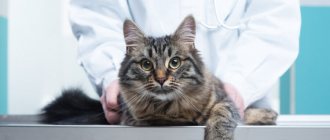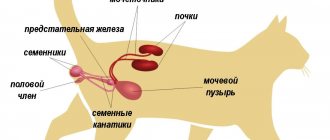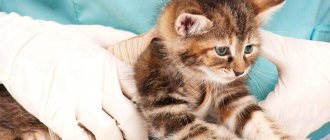9767Administration
If the owner of a British cat does not want to have offspring from his pet in the future, then he should think about castrating the animal. And after carrying out this procedure, you can forget about the possible consequences of the marriage period. But first of all, you need to find out at what age British cats are castrated. This is necessary to protect your pet from side effects in case of late presentation to the clinic.
Another good reason to neuter your pet is the large number of individuals, not only British, but also Scottish Folds or representatives of other breeds. Therefore, many cat lovers decide to perform such an operation on their pet.
What is castration?
During the castration process, the testes are removed, which leads to the cessation of the reproductive function of the body. In cats, an attraction to cats appears already at 7 months of life. This craving greatly affects their behavior. Animal owners can expect heartbreaking screams at night, aggressive behavior and constant marking of territory in the apartment, which causes a terrible smell.
To avoid all of the above troubles and continue to enjoy the company of your calm and friendly pet, you need to castrate your cat 7-8 months after birth. This way, the kitten will be strong enough to endure surgery and will recover quickly after it.
Veterinarians claim that castration is not a complicated operation and cannot lead to any bad consequences. But despite all the assurances of doctors, you should rely primarily on the age of the pet. If the animal is old, then problems may arise with tolerating anesthesia, because the body of a mature pet is not so strong. Therefore, risks always exist, and before going to a veterinary clinic, you need to carefully weigh the pros and cons.
Features of sterilization at different ages
Sterilization of cats
Sometimes owners at a veterinary clinic ask the question: “At what age should a British Fold cat be neutered?” First of all, the doctor usually explains that such a breed simply does not exist. Only the Scots have lop ears, the British do not. This confusion is due to the fact that many years ago interbreed matings were allowed, which are now prohibited. It was then that people had the wrong opinion about the British, although they have standard ears, the same as all ordinary cats.
Optimal age for castration of a British cat
The optimal age for castration of a cat depends on its breed.
It is necessary to choose the most appropriate moment when it will be safest to castrate a British cat. This age ranges from 7 to 8 months.
It is optimal to perform the operation at a time when the kitten is strong enough to tolerate anesthesia, and at the same time he has not yet begun his sexual life.
Otherwise there are no restrictions. An adult cat can be neutered at any time at the owner's request. But it is necessary to understand that each animal has its own characteristics. Therefore, surgery should be scheduled only after a thorough examination by a veterinarian, who will make a final decision.
You should pay attention to a number of situations in which castration is prohibited, regardless of age:
- obesity;
- stress state of the animal;
- intolerance to anesthesia;
- weakened immune system;
- temporary health problems or chronic diseases.
Why do they do this?
For breeders involved in breeding feline breeds, the issue of castration of animals is not relevant. The main goal for them is to obtain healthy offspring from elite specimens.
For other cat owners, castration is a solution to many problems, the main one of which is the adjustment of the animal’s behavior, which changes with the onset of puberty. Puberty of cats of different breeds occurs at different periods, it depends on individual characteristics. The average time of the first sexual heat is from 7 to 9 months of life. At this age, males become ready to continue their race.
Why do cats need castration? The answer is simple: nature created the cat family to live in the wild. The instinct of reproduction is inherent in every biological species to maintain population size. Protecting people has eliminated most of the dangers facing animals in their natural habitats. As a result, the need for intensive procreation also disappeared. It is obvious that a verbal suggestion not to reproduce will not enlighten our smaller brothers. Therefore, a person must make a decision for them. The only way out is to artificially stop the possibility of procreation, which is castration of the cat.
Changes in behavior
At the onset of puberty, sex hormones begin to have a significant influence on the cat’s behavior. The reproductive instinct awakens. This manifests itself in the following:
- Unreasonable aggression towards people and other pets. It is expressed in the fact that the cat rushes at its potential enemy, scratches, bites;
- apathy that follows outbursts of aggressive behavior;
- loud meowing, more like a roar, often at night. This indicates nervous overexcitation;
- the desire to mark its habitat with urine. During this period, the discharge acquires a particularly unpleasant, persistent odor. With the help of marks, the cat makes it clear to its rivals that this is its territory and attracts females for mating;
- manifestation of dominant behavior by scratching furniture and other interior items;
- refusal to eat. The result is weight loss and hair loss.
When and why do they castrate?
Britons, like other breeds, are neutered for a variety of reasons. This could be due to excessive aggression, noise, bad behavior of the animal, or the owners do it for medical reasons.
Another reason why many owners bring their pets to the clinic is the appearance of unwanted offspring. You need to be responsible for the animal and understand that its walk may lead to the birth of homeless kittens.
Despite all the recommendations on the optimal age for castration of an animal, the decision about when to perform the operation remains with the owner. To decide on the time, you need to familiarize yourself with all the advantages of early and late castration.
Early castration is the infertility of a kitten in the second month of life. One of the advantages is that the organs and tissues of the animal are still tender. This is the best time to castrate a cat for biological purposes.
At such a young age, the likelihood of bleeding and other complications is minimal. The occurrence of a painful effect in such cases is practically not observed. In most cases, the kitten returns to normal within a few hours after the operation and runs around the house, although you should not allow it to do this.
But there are negative aspects to early castration. An unpleasant consequence may be slow development of the body. Gaining muscle mass depends on the level of sex hormones in the blood, but after removal of the testes, their production stops. Early sterilization leads to the fact that even in the fifth year of life the cat looks more like a kitten than an adult animal. Also, early intervention threatens the appearance of problems with the heart and joints.
A cat can be neutered in adulthood, but late sterilization does not have many advantages. It is easier to operate on already formed tissues and organs, but this is the only advantage of this procedure. The development of the animal for a long time took place with the participation of sex hormones, so the character of the cat and its habits were formed partly under their influence, and after castration the pet can change beyond recognition. In addition, sutures on hard tissues are placed worse and the likelihood of internal bleeding is quite high.
After late castration, the animal owner needs to prepare for a complete change in the cat’s diet, because the metabolism will be slowed down by 25%. Otherwise, the pet will develop problems with excess weight.
Adult cats have a lower pain threshold than kittens, so the likelihood of pain shock is higher.
Features of the operation
A well-done castration of a British cat will help him avoid displaying aggressiveness towards others during sexual activity. Moreover, this is a simple operation, which in most cases is performed at home.
Many British, Scottish and other similar breeds that need to be neutered may have a congenital heart defect.
It can be determined by performing the necessary procedures on your cat in the clinic, namely ECHO and ECG of this organ. And only after such manipulations, if everything is normal, can the Briton be safely castrated. If any difficulties arise in your kitten, you need to notify your doctor before surgery.
© shutterstock
Medical point of view
Experts highlight a number of advantages of this operation:
- animals that have been castrated live several years longer;
- this is the best method to wean your pet from marking its territory;
- the cat stops screaming, asking to go outside and running around looking for the cat;
- castration helps to avoid the appearance of prostatitis, adenoma and other diseases of the genital area;
- prevention of breast tumors.
Despite the numerous advantages of the operation, you should familiarize yourself with all the disadvantages of this process, and only then take the kitten to the doctor. After removal of the testes, the cat becomes lazier, moves little, and because of this, the risk of excess weight problems increases, because the animal spends almost no energy. The British often have problems with the cardiovascular system, and after castration the risk of such diseases increases. Urolithiasis is also possible.
It is important to assess the risk and consult with a specialist about whether the animal will tolerate anesthesia. In the rarest cases, the operation entails complications, but with proper care and nutrition, everything will be fine with the pet.
Preparing for castration
Preparing a cat for castration is a necessary step. First of all, you need to make sure that the animal is completely healthy. To do this, you should show your pet to a specialist and conduct a series of examinations, as well as undergo biochemical and general urine and blood tests. Afterwards, the Briton is examined for the presence of hidden infections that enter the body through sexual contact. It would not be superfluous to show the cat not only to a therapist, but also to a cardiologist.
Before surgery, it is necessary to treat the animal for helminths and external parasites.
These procedures are carried out once every 3 months, but 10 days before castration they do unscheduled deworming. The exception is those cases when treatment for worms took place less than a month ago. In such cases, there is no need to reuse the drug.
It happens that an unvaccinated animal is registered for surgery. This is wrong, but in exceptional situations, doctors allow the procedure to be carried out after injecting the cat with a special substance that supports immunity for several weeks. In most cases, vaccinations are mandatory, because a vaccinated animal is much less likely to develop an infectious disease after surgery.
During castration, a dose of narcotic substances enters the animal’s body, the side effect of which is vomiting. An animal may vomit both during and after anesthesia. Therefore, it would be wise not to feed your pet before surgery. Refusal to eat begins 12 hours before surgery. The pet will not suffer at all from this.
Before going to the hospital, you need to take with you your pet’s passport, which contains all the vaccination dates, a carrier with a hinged lid, bedding and napkins.
Methods for sterilizing a cat
There are three main methods of performing surgery to remove the genital organs of a cat:
- Classic (along the white line). An incision ranging from one and a half to five centimeters in length is made in the central part of the abdomen below the navel. The peritoneal wall is incised between the muscles. After the uterus and ovaries are removed, the blood vessels are ligated with surgical absorbable suture. Sutures are placed on the peritoneal wall and skin. If no absorbable suture was used to place the stitches, they will need to be removed after two weeks. During this time, the animal must wear a medical blanket to protect the suture from infection.
- Side cut. This method does not require complex postoperative care for sutures. It is used to sterilize stray cats, which are released into the wild immediately after surgery. Most often, only the ovaries are removed using this method.
- The laparoscopic method is named after the instrument used for the operation. A laparoscope is a device for penetrating body cavities without traumatic damage to external tissues. To insert it into the body, you only need a tiny incision. The laparoscope is equipped with a video camera that helps the surgeon monitor the progress of the operation. To increase visibility during manipulations, the abdominal cavity is filled with carbon dioxide. The ovaries and uterus are removed through a small hole.
The advantages of this method include:
- practically painless;
- access to the abdominal cavity through a small puncture causes minimal tissue trauma;
- visual control at all stages of the operation;
- there is no possibility of infection;
- no postoperative care is required.
Due to the high cost of equipment, the laparoscopic method is more expensive, which all veterinary clinics cannot afford and there are no specialists with the necessary skills.
Any of the surgical methods requires the use of general anesthesia.
Postoperative sutures in cats
After sterilization, a suture is placed on the incision. When suturing the peritoneal wall, use catgut or synthetic absorbable threads. Postoperative care of the suture consists of periodic treatment with a disinfectant.
Classification of seams:
- The classic knot is reliable, but not flawless from an aesthetic point of view. Designed for a yard cat for which it is impossible to provide full supervision. Since she will try to remove the seam with her tongue, maximum strength is needed.
- Continuous interrupted skin suture - the doctor removes it 10 days after surgery. It does not cause too much damage to the skin and resolves after a few months.
- A continuous intradermal suture does not require removal. It is performed with a thread that will resolve (completely heal) a couple of months after the operation.
Surgery and aftercare
The procedure time ranges from 30 minutes to one and a half hours. After castration, the cat is either left for foster care at the clinic or immediately taken home.
You should be prepared for the fact that the first few weeks of caring for the animal will take much more time than before. You should transport your pet exclusively in a carrier, because when recovering from anesthesia, it can harm itself or others. Air should flow into the carrier, and a waterproof diaper should be laid on the bottom.
After anesthesia, the animal temporarily loses its ability to thermoregulate and may freeze. This should not be allowed under any circumstances. You can use a plastic bottle with warm water or a heating pad. But you should not apply it to the wound site, as bleeding may begin. Until your pet is fully awake, he should lie on his side.
At home, you should not place a cat near a radiator, in a draft or in high places. It is important to ensure that the animal lies on its side and does not choke in case of a gag reflex. During anesthesia, cats' eyelids do not close, so their eyes dry out. The owner will have to close the animal’s eyelids every half hour or gently massage the eyes. If the cat does not recover from anesthesia for a long time, then special drops are instilled into the eyes.
For the first few days, it is better to put an Elizabethan collar around the cat’s neck, even if the pet behaves calmly. For several months, you need to carefully monitor changes in the animal’s weight and make appropriate changes to the diet.
Differences between sterilization of young and adult individuals
Adult cats (over 1 year old) are also sterilized, although they are much more difficult to tolerate the procedure. To maintain the health of your pet, sterilization should be carried out after a full examination.
One of the negative consequences may be the formation of tumors, such as the development of breast cancer. If a cat has already had more than 2 periods of heat, the likelihood of developing cancerous tumors exceeds 25%.
The owners of a British cat must approach this issue responsibly so that the animal lives a long and healthy life. Experts believe that to prevent complications, the operation should be carried out at the optimal time.
Feeding a neutered cat
The portion size for a British castrated cat should be reduced by 25%, because after castration the metabolism deteriorates. You should not give your cat fish, because salts and minerals begin to be absorbed worse. It is important to feed your pet only specialized food for cats after castration. It is necessary to give food more often, but in small quantities. The animal should always have access to water.
All information posted on the site is provided in accordance with the User Agreement and is not a direct instruction to action. We strongly recommend that before using any product, you must obtain a face-to-face consultation at an accredited veterinary clinic.
Postoperative cat care
Caring for your pet after castration is necessary, as negative consequences of castration of cats may occur.
The animal suffers pain and experiences psychological discomfort, so you need to try to speed up the rehabilitation process:
- You can pick up your pet from the clinic only after the anesthesia has worn off.
- In the first 48 hours after surgery, it is not recommended to take the animal outside or place it in unfamiliar places. You should try to avoid drafts, sharp sounds and noise.
- If possible, it would be good not to leave your pet alone on the first day after castration. It can rip off the postoperative bandage and stretch the stitches, causing inflammation and irritation of the skin.
- The pet's bedding should be soft, it is better if it is made of natural fabrics. It will be difficult for the cat to get to the tray, so you need to change the litter several times a day.
- After the operation, your pet will be drowsy and tired, you need to give him time to rest and recover. No need to bother the cat, and no need to pick him up.
- It is not recommended to feed your pet in the first 24 hours after surgery. Access to drinking warm water must be constant. Due to weakness and the residual effect of anesthesia, it can be difficult for a cat to get up and walk to a cup of water; it is necessary that the bowl be standing nearby.
- With the help of a veterinarian, you need to select specialized food for neutered animals that is suitable for your pet, and strictly adhere to the norm and diet.
- During the rehabilitation period, it is necessary to limit the cat’s movement on furniture, window sills and ledges in the walls, since, by unsuccessfully jumping or falling, the cat can damage the operation site.











